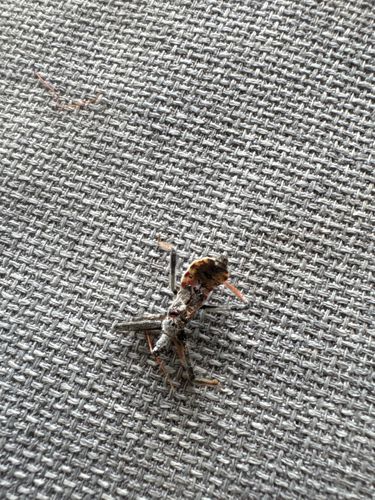Dirt-carrying assassin bug (or Masked Hunter nymph)
Scientific Name: Reduvius personatus (This is the species most commonly associated with the 'masked hunter' or 'dirt-carrying assassin bug' that enters homes as a nymph.)
Order & Family: Order: Hemiptera, Family: Reduviidae
Size: Nymphs can range from a few millimeters to about 18-20 mm (0.7-0.8 inches) as they mature. Adults are typically 17-22 mm (0.7-0.9 inches) long.

Natural Habitat
Outdoors, they can be found in gardens, under rocks, or in other sheltered areas. Indoors, they often inhabit dusty areas, attics, basements, wall voids, and can sometimes be found near beds if bed bugs are present, as they prey on them. Their camouflage makes them difficult to spot.
Diet & Feeding
They are predatory, feeding on a variety of small arthropods, including bed bugs, carpet beetles, and other household pests. They use their piercing-sucking mouthparts (rostrum) to inject venom into their prey, liquefying the insides, which they then suck out.
Behavior Patterns
Dirt-carrying assassin bugs are ambush predators. Nymphs camouflage themselves by covering their bodies with debris (soil particles, lint, dead insects) which helps them hide from both predators and prey. They are generally slow-moving but can strike quickly when prey is near. They undergo incomplete metamorphosis (egg, nymph, adult).
Risks & Benefits
Risks: While generally not aggressive, they can deliver a painful bite if provoked or handled, similar to a bee sting. Their bite is not venomous to humans but can cause localized pain and swelling. Benefits: They are beneficial as natural predators of many common household pests, including bed bugs, carpet beetle larvae, and other small insects.
Identified on: 7/24/2025